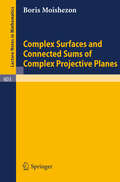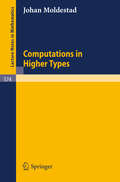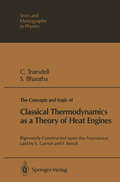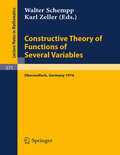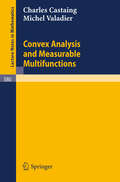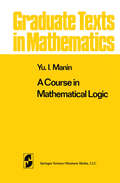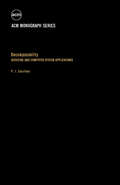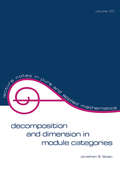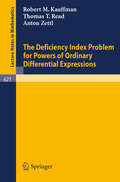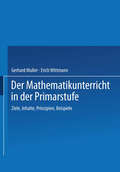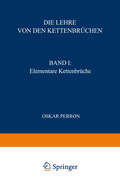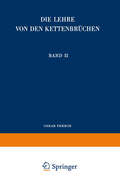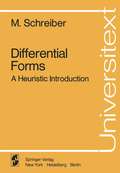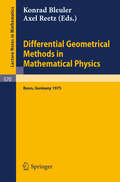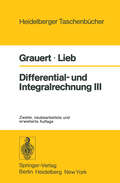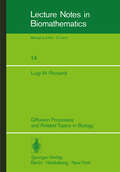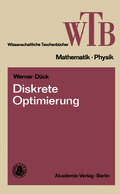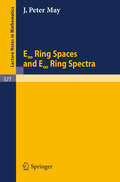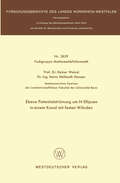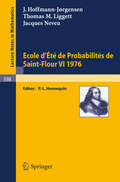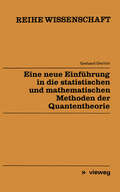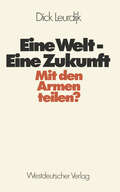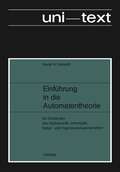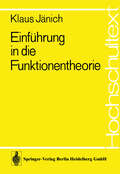- Table View
- List View
Complex Surfaces and Connected Sums of Complex Projective Planes (Lecture Notes in Mathematics #603)
by B. MoishezonThe Concepts and Logic of Classical Thermodynamics as a Theory of Heat Engines: Rigorously Constructed upon the Foundation Laid by S. Carnot and F. Reech (Theoretical and Mathematical Physics)
by Clifford A. Truesdell Subramanyam BharathaMon but n'a jamais be de m'occuper des ces matieres comme physicien, mais seulement comme /ogicien ... F. REECH, 1856 I do not think it possible to write the history of a science until that science itself shall have been understood, thanks to a clear, explicit, and decent logical structure. The exuberance of dim, involute, and undisciplined his torical essays upon classical thermodynamics reflects the confusion of the theory itself. Thermodynamics, despite its long history, has never had the benefit of a magisterial synthesis like that which EULER gave to hydro dynamics in 1757 or that which MAXWELL gave to electromagnetism in 1873; the expositions in the works of discovery in thermodynamics stand a pole apart from the pellucid directness of the notes in which CAUCHY presented his creation and development of the theory of elasticity from 1822 to 1845. Thermodynamics was born in obscurity and disorder, not to say confusion, and there the common presentations of it have remained. With this tractate I aim to provide a simple logical structure for the classical thermodynamics of homogeneous fluid bodies. Like any logical structure, it is only one of many possible ones. I think it is as simple and pretty as can be.
Constructive Theory of Functions of Several Variables: Proceedings of a Conference Held at Oberwolfach, April 25 - May 1, 1976 (Lecture Notes in Mathematics #571)
by W. Schempp K. ZellerConvex Analysis and Measurable Multifunctions (Lecture Notes in Mathematics #580)
by C. Castaing M. ValadierA Course in Mathematical Logic (Graduate Texts in Mathematics #53)
by Yu.I. Manin1. This book is above all addressed to mathematicians. It is intended to be a textbook of mathematical logic on a sophisticated level, presenting the reader with several of the most significant discoveries of the last ten or fifteen years. These include: the independence of the continuum hypothe sis, the Diophantine nature of enumerable sets, the impossibility of finding an algorithmic solution for one or two old problems. All the necessary preliminary material, including predicate logic and the fundamentals of recursive function theory, is presented systematically and with complete proofs. We only assume that the reader is familiar with "naive" set theoretic arguments. In this book mathematical logic is presented both as a part of mathe matics and as the result of its self-perception. Thus, the substance of the book consists of difficult proofs of subtle theorems, and the spirit of the book consists of attempts to explain what these theorems say about the mathematical way of thought. Foundational problems are for the most part passed over in silence. Most likely, logic is capable of justifying mathematics to no greater extent than biology is capable of justifying life. 2. The first two chapters are devoted to predicate logic. The presenta tion here is fairly standard, except that semantics occupies a very domi nant position, truth is introduced before deducibility, and models of speech in formal languages precede the systematic study of syntax.
Decomposability: Queueing and Computer System Applications
by P. J. CourtoisDecomposability: Queueing and Computer System Applications presents a set of powerful methods for systems analysis. This 10-chapter text covers the theory of nearly completely decomposable systems upon which specific analytic methods are based.The first chapters deal with some of the basic elements of a theory of nearly completely decomposable stochastic matrices, including the Simon-Ando theorems and the perturbation theory. The succeeding chapters are devoted to the analysis of stochastic queuing networks that appear as a type of key model. These chapters also discuss congestion problems in information processing systems, which could be studied by the queuing network models. A method of analysis by decomposition and aggregation for these models is proposed. Other chapters highlight the problem of computer system performance evaluation, specifically the analysis of hardware and software of the dynamic behavior of computer systems and user programs. These topics are followed by a description of an aggregative model of a typical multiprogramming time-sharing computer system. The last chapter examines the existing affinity between the concept of aggregate in nearly completely decomposable structures and the notions of module and level of abstraction so frequently invoked in computer system design and software engineering. This book will prove useful to both hardware and software designers and engineers, as well as scientists who are investigating complex systems.
Decomposition and Dimension in Module Categories
by Jonathan S. GolanThis book examines the notions of dimension and decomposition for module categories. It discusses some basic properties of quasidecomposition functions and the complete lattice of all quasidecomposition functions taking values in a fixed given lattice.
Decomposition and Dimension in Module Categories
by Jonathan S. GolanThis book examines the notions of dimension and decomposition for module categories. It discusses some basic properties of quasidecomposition functions and the complete lattice of all quasidecomposition functions taking values in a fixed given lattice.
The Deficiency Index Problem for Powers of Ordinary Differential Expressions (Lecture Notes in Mathematics #621)
by Robert M. Kauffman Thomas T. Read Anton ZettlDer Mathematikunterricht in der Primarstufe: Ziele · Inhalte, Prinzipien · Beispiele
by Gerhard Müller Erich Ch. WittmannNach einer stürmischen Bewegung in den sechzigerund Anfang der siebziger Jahre befindet sich der Mathematikunterricht in der Grundschule seit etwa zwei Jahren zweifellos in einer Phase der Konsolidierung, mit der eine kritische Revision der bisherigen didaktischen Ent wicklungen und eine Trennung von Spreu und Weizen einhergehen. Es mag mancher.1 Kollegen im gegenwärtigen Zeitpunkt als zu früh erscheinen, wenn wir mit dem vorliegenden Buch eine "Didaktik" des Mathematikunterrichts in der Grund schule vorlegen. Auch wir selbst sind uns sehr bewußt, daß unsere Konzeption nicht in dem Umfang erprobt und überarbeitet ist, wie man es wünschen möchte und wie es z. B. bei den traditionellen Rechendidaktiken in der Regel der Fall war. Wir haben uns aber trotzdem aus drei Gründen zu einer Publikation entschlossen. Erstens halten wir es für notwendig, daß die Lehrerschaft am Prozeß der weiteren Konsoli dierung mitarbeiten kann, und glauben, daß dazu Orientierungsrahmen angeboten werden müssen, innerhalb deren experimentiert und diskutiert werden kann. Das vorliegende Buch entwickelt einen solchen Rahmen.
Die Lehre von den Kettenbrüchen: Band I: Elementare Kettenbrüche
by Oskar Perroneigenen Begriffssystemen bereichert worden, die man nicht gerade als jedermann geläufig voraussetzen darf. Die Versuchung lag nahe, durch Heranziehung solcher Theorien den Kettenbrüchen einen gelehrteren Anstrich zu geben. Aber dadurch wäre nicht nur die Lektüre unnötig erschwert, sondern das Wesen der Dinge zumeist verschleiert worden, und es bestände die Gefahr, daß mancher Leser den künstlichen Anstrich für das Wesentliche halten und die harmlose Unschuld, die sich darunter verbirgt, vielleicht gar nicht mehr sehen würde. Deshalb habe ich auf logistische Hieroglyphen, geheimnisvolle "Räume" usw. verzichtet und bin bei der klassischen Wortsprache und den klassischen Rechenmethoden ge blieben. Lediglich zweireihige Matrizes wurden gelegentlich verwandt, nämlich da, wo sie einen wirklichen methodischen Vorteil bieten. Der Matrixkalkül ist ja heute in viel weiteren Kreisen bekannt als vor 40 Jahren und gehört fast schon zu den Elementen; ich habe ihn trotzdem nicht vorausgesetzt, sondern in § 5 das Wenige, was davon gebraucht wird, kurz zusammengestellt. In neuerer Zeit haben die Kettenbrüche auch in der augewandten Mathematik, z. B. in der Elektrotechnik und bei analytischen Approximationsmethoden, Verwendung ge funden. Auch den Vertretern dieser Disziplinen, sowie manchen interessierten Laien, die es trotz unseres materialistischen Zeitalters doch immer noch gibt, glaube ich durch leichte Verständlichkeit besser zu dienen als durch Paradieren mit einer übertriebenen Gelehrsamkeit. Auf die Beigabe einer möglichst lückenlosen Bibliographie habe ich ebenso wie früher verzichtet; man findet eine solche, die von den Anfängen bis ins erste Jahrzehnt unseres Jahrhunderts reicht, bei Wölffing 1.
Die Lehre von den Kettenbrüchen: Band II: Analytisch-funktionentheoretische Kettenbrüche
by Oskar PerronNunmehr kann ich auch den zweiten Teil meiner Lehre von den Kettenbrüchen, der den analytischen Kettenbrüchen gewidmet ist, als Band 11 in neuer Be arbeitung den Fachgenossen vorlegen. Ebenso wie bei dem im Jahr 1954 er schienenen Band I ging mein Bemühen dah~, den heutigen Stand der Wissen schaft in möglichst leicht verständlicher Weise darzustellen. Die leichte Ver ständlichkeit kann natürlich nicht bedeuten, daß der Leser das Buch wie einen Roman durcheilen kann. Wenn er aber die Technik der Differential-und Integral rechnung beherrscht, wenn er schon etwas von der Gammafunktion und von linearen Differentialgleichungen gehört hat und ein klein wenig Funktionen theorie weiß, kann er unschwer folgen; nur darf er, um in Einzelheiten ein zudringen, nicht die Mühe scheuen, gelegentlich Papier und Bleistift zur Hand zu nehmen und einfache Rechnungen nach gegebener Anweisung selbst durch zuführen. Es geht alles nach geläufigen Methoden. Der allgemeine Rahmen des Buches ist der alte geblieben; doch sind die sechs Kapitel mit weitgehend verändertem Inhalt gefüllt. Namentlich die ersten drei und auch die zweite Hälfte des vierten sind mannigfach umgestaltet und er weitert, während in den letzten zwei nur geringere Änderungen nötig und sogar Kürzungen möglich waren, um Raum für den neuen Stoff der früheren zu ge winnen. Überall in der Welt, besonders in der Neuen, ist in den letzten Dezennien ein reiches Material von neuen Kettenbruchtypen und neuen Erkenntnissen, vor allem in bezug auf Konvergenz, gewonnen worden, das gesichtet, geordnet und systematisch eingearbeitet werden mußte.
Differential Forms: A Heuristic Introduction (Universitext)
by M. SchreiberA working knowledge of differential forms so strongly illuminates the calculus and its developments that it ought not be too long delayed in the curriculum. On the other hand, the systematic treatment of differential forms requires an apparatus of topology and algebra which is heavy for beginning undergraduates. Several texts on advanced calculus using differential forms have appeared in recent years. We may cite as representative of the variety of approaches the books of Fleming [2], (1) Nickerson-Spencer-Steenrod [3], and Spivak [6]. . Despite their accommodation to the innocence of their readers, these texts cannot lighten the burden of apparatus exactly because they offer a more or less full measure of the truth at some level of generality in a formally precise exposition. There. is consequently a gap between texts of this type and the traditional advanced calculus. Recently, on the occasion of offering a beginning course of advanced calculus, we undertook the expe- ment of attempting to present the technique of differential forms with minimal apparatus and very few prerequisites. These notes are the result of that experiment. Our exposition is intended to be heuristic and concrete. Roughly speaking, we take a differential form to be a multi-dimensional integrand, such a thing being subject to rules making change-of-variable calculations automatic. The domains of integration (manifolds) are explicitly given "surfaces" in Euclidean space. The differentiation of forms (exterior (1) Numbers in brackets refer to the Bibliography at the end.
Differential Geometrical Methods in Mathematical Physics: Proceedings of the Symposium Held at the University at the University of Bonn, July 1 - 4, 1975 (Lecture Notes in Mathematics #570)
by K. Bleuler A. ReetzDifferential- und Integralrechnung III: Integrationstheorie Kurven- und Flächenintegrale Vektoranalysis (Heidelberger Taschenbücher #43)
by H. Grauert I. LiebDiffusion Processes and Related Topics in Biology (Lecture Notes in Biomathematics #14)
by Luigi M. RicciardiThese notes are based on a one-quarter course given at the Department of Biophysics and Theoretical Biology of the University of Chicago in 1916. The course was directed to graduate students in the Division of Biological Sciences with interests in population biology and neurobiology. Only a slight acquaintance with probability and differential equations is required of the reader. Exercises are interwoven with the text to encourage the reader to play a more active role and thus facilitate his digestion of the material. One aim of these notes is to provide a heuristic approach, using as little mathematics as possible, to certain aspects of the theory of stochastic processes that are being increasingly employed in some of the population biol ogy and neurobiology literature. While the subject may be classical, the nov elty here lies in the approach and point of view, particularly in the applica tions such as the approach to the neuronal firing problem and its related dif fusion approximations. It is a pleasure to thank Professors Richard C. Lewontin and Arnold J.F. Siegert for their interest and support, and Mrs. Angell Pasley for her excellent and careful typing. I . PRELIMINARIES 1. Terminology and Examples Consider an experiment specified by: a) the experiment's outcomes, ~, forming the space S; b) certain subsets of S (called events) and by the probabilities of these events.
